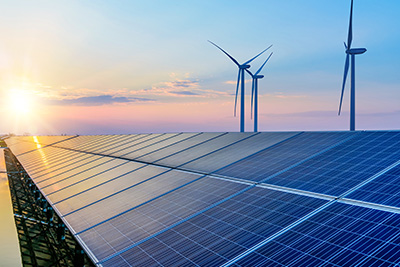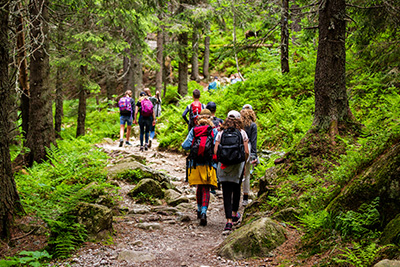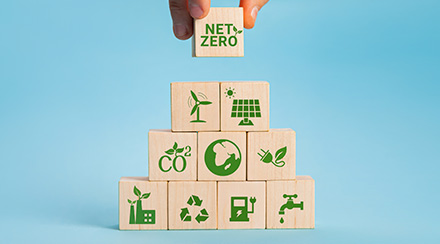What Is Renewable Energy, or Clean Energy?

It’s easy to think of renewable energy as cutting edge; we often associate it with solar panels and wind farms, and consider it to be the future of energy production. But this is only partially true – before mankind learned how to use nonrenewable energy sources like coal, oil and natural gas, we relied on sunshine and wind for the energy we needed to travel, prepare food, stay warm and much more.
Wind and solar energy have been abundant for thousands of years, and they’ll be around for thousands more. With our rapidly advancing technology, we’re doing more with those energy sources than ever before, as well as adding other renewables to the energy mix.
What Is Renewable Energy?
Renewable energy refers to energy sources that replenish themselves naturally and continuously. Renewable energy sources include solar, wind, geothermal and biomass – energy that comes from the processing of organic material. Other energy sources like coal, oil and gas are considered nonrenewable because of the extremely long processes that cause them to form. We’re consuming these energy sources much faster than they can be replenished. And there’s another big difference between them and most of the renewable energy sources we use – renewables are cleaner.
Coal, oil and gas produce emissions that are harmful to the environment, which is why they’re often called dirty energy sources. Most renewables produce no harmful emissions, which is why we call them clean energy sources.
Energy Resources That Are Renewable
Most renewable energy production falls into one of five categories:

- Solar energy: The most common way we harvest the energy that flows freely from the sun is through rooftop solar panels and utility-scale solar farms, which convert solar energy into electricity. But there are all sorts of other applications of solar energy, including heating water, dehydrating food and even cooking. Learn more about solar energy.
- Wind energy: Most wind energy produced today comes from massive windmills and turbines that generate electricity. But old-fashioned windmills are still in operation in some applications, such as farms that use steel windmills to help pump well water for irrigation and feeding livestock.
- Geothermal: While the temperature above ground fluctuates with the seasons, the temperature below ground is comparatively stable. Heat emanating from the earth’s molten core radiates outward toward the earth’s crust, and we can capture that heat energy using geothermal technology. Geothermal energy is used for indoor climate control, water heating, electricity generation and more.
- Biomass: One of mankind’s oldest forms of energy – burning wood for cooking and warmth – is an example of biomass energy. Burning or processing organic matter can produce emissions, so biomass is not as reliably clean as solar and wind, but it is renewable. The most modern forms of biomass energy include the production of ethanol fuel from agricultural products and the generation of renewable natural gas from sewage treatment.
What Are the Benefits of Renewable Energy?
Nonrenewable energy sources revolutionized the way we worked, traveled and lived in the late 19th century, and they’ve been the foundation of our energy supply ever since. But that’s beginning to change as we ramp up our production of renewable energy and reduce our dependence on fossil fuels.
This new energy revolution brings numerous benefits:
- Renewable energy is constantly replenished, compared to fossil fuel supplies, which are dwindling.
- Renewables are clean and do not contribute to climate change or air pollution.
- Renewable energy is accessible virtually everywhere, whereas fossil fuels are concentrated in a limited number of regions.
- Renewable energy sources like solar are well suited for small-scale applications, like powering individual homes. This provides a layer of energy security and independence, and helps reduce pressure on the electrical grid.
- While there is an upfront cost to manufacturing and installing renewable energy equipment like solar panels and wind turbines, the fuel source itself is free. This helps reduce and stabilize energy costs.
- The growth of our renewable energy infrastructure creates thousands of new jobs in the energy sector.
How Can I Start Using Renewable Energy Sources?
If you want to get directly involved in the clean energy revolution, there are a few things you can do:
- Install residential rooftop solar panels. With the availability of tax credits and other incentives, solar panels may be more affordable than you think, depending on how many solar panels you need for your home. And because they reduce your electricity bills, they pay for themselves in time.
- Find ways to invest in renewable energy certificates, or RECs. These certificates represent green energy production and can offset the environmental impact of energy you buy from nonrenewable sources, lowering your carbon footprint. For most individuals, the best way to invest in RECs is to enroll in green energy plans offered by electricity suppliers and utilities. These plans may not be available everywhere, but are growing in popularity.
- Look into geothermal heating and cooling. Find out if your home and budget are a good fit for a geothermal heating and cooling system. Geothermal heat pumps are far more efficient than traditional heating and cooling systems, and they generally require less maintenance. But there are certain environments in which they can’t be installed, and they have a higher upfront installation cost than other systems. Like solar panels, however, geothermal heat pumps will pay for themselves over time.
Renewable, green energy is as good for your wallet as it is for the planet. You should expect to see more and more renewable energy production as we forge our path to a clean energy future.
Looking for Something Specific?
Select a category to find resources for topics that interest you.
Select Category

Related Articles:

What Are Carbon Offsets?
Carbon offsets help account for the carbon emissions produced by your daily activities. These offsets go toward projects that have a positive impact on the environment, like reforestation or renewable energy production.
Read Article
What is a Carbon Footprint and How to Reduce It
We all know some basic steps we can take to safeguard the environment, but some of the most significant changes we can make involve the way we use energy at home.
Read Article
What Is Wind Energy?
From windmills to modern wind turbines, we've been using technology to harness the power of wind for centuries. Learn how wind energy works today and the advantages and disadvantages of this type of renewable energy.
Read ArticleWhat Is Renewable Energy, or Clean Energy?
It’s easy to think of renewable energy as cutting edge; we often associate it with solar panels and wind farms, and consider it to be the future of energy production. But this is only partially true – before mankind learned how to use nonrenewable energy sources like coal, oil and natural gas, we relied on sunshine and wind for the energy we needed to travel, prepare food, stay warm and much more.
Wind and solar energy have been abundant for thousands of years, and they’ll be around for thousands more. With our rapidly advancing technology, we’re doing more with those energy sources than ever before, as well as adding other renewables to the energy mix.
What Is Renewable Energy?
Renewable energy refers to energy sources that replenish themselves naturally and continuously. Renewable energy sources include solar, wind, geothermal and biomass – energy that comes from the processing of organic material. Other energy sources like coal, oil and gas are considered nonrenewable because of the extremely long processes that cause them to form. We’re consuming these energy sources much faster than they can be replenished. And there’s another big difference between them and most of the renewable energy sources we use – renewables are cleaner.
Coal, oil and gas produce emissions that are harmful to the environment, which is why they’re often called dirty energy sources. Most renewables produce no harmful emissions, which is why we call them clean energy sources.
Energy Resources That Are Renewable
Most renewable energy production falls into one of five categories:
- Solar energy: The most common way we harvest the energy that flows freely from the sun is through rooftop solar panels and utility-scale solar farms, which convert solar energy into electricity. But there are all sorts of other applications of solar energy, including heating water, dehydrating food and even cooking. Learn more about solar energy.
- Wind energy: Most wind energy produced today comes from massive windmills and turbines that generate electricity. But old-fashioned windmills are still in operation in some applications, such as farms that use steel windmills to help pump well water for irrigation and feeding livestock.
- Geothermal: While the temperature above ground fluctuates with the seasons, the temperature below ground is comparatively stable. Heat emanating from the earth’s molten core radiates outward toward the earth’s crust, and we can capture that heat energy using geothermal technology. Geothermal energy is used for indoor climate control, water heating, electricity generation and more.
- Biomass: One of mankind’s oldest forms of energy – burning wood for cooking and warmth – is an example of biomass energy. Burning or processing organic matter can produce emissions, so biomass is not as reliably clean as solar and wind, but it is renewable. The most modern forms of biomass energy include the production of ethanol fuel from agricultural products and the generation of renewable natural gas from sewage treatment.
What Are the Benefits of Renewable Energy?
Nonrenewable energy sources revolutionized the way we worked, traveled and lived in the late 19th century, and they’ve been the foundation of our energy supply ever since. But that’s beginning to change as we ramp up our production of renewable energy and reduce our dependence on fossil fuels.
This new energy revolution brings numerous benefits:
- Renewable energy is constantly replenished, compared to fossil fuel supplies, which are dwindling.
- Renewables are clean and do not contribute to climate change or air pollution.
- Renewable energy is accessible virtually everywhere, whereas fossil fuels are concentrated in a limited number of regions.
- Renewable energy sources like solar are well suited for small-scale applications, like powering individual homes. This provides a layer of energy security and independence, and helps reduce pressure on the electrical grid.
- While there is an upfront cost to manufacturing and installing renewable energy equipment like solar panels and wind turbines, the fuel source itself is free. This helps reduce and stabilize energy costs.
- The growth of our renewable energy infrastructure creates thousands of new jobs in the energy sector.
How Can I Start Using Renewable Energy Sources?
If you want to get directly involved in the clean energy revolution, there are a few things you can do:
- Install residential rooftop solar panels. With the availability of tax credits and other incentives, solar panels may be more affordable than you think, depending on how many solar panels you need for your home. And because they reduce your electricity bills, they pay for themselves in time.
- Find ways to invest in renewable energy certificates, or RECs. These certificates represent green energy production and can offset the environmental impact of energy you buy from nonrenewable sources, lowering your carbon footprint. For most individuals, the best way to invest in RECs is to enroll in green energy plans offered by electricity suppliers and utilities. These plans may not be available everywhere, but are growing in popularity.
- Look into geothermal heating and cooling. Find out if your home and budget are a good fit for a geothermal heating and cooling system. Geothermal heat pumps are far more efficient than traditional heating and cooling systems, and they generally require less maintenance. But there are certain environments in which they can’t be installed, and they have a higher upfront installation cost than other systems. Like solar panels, however, geothermal heat pumps will pay for themselves over time.
Renewable, green energy is as good for your wallet as it is for the planet. You should expect to see more and more renewable energy production as we forge our path to a clean energy future.
Looking for Something Specific?
Select a category to find resources for topics that interest you.
Select Category

Related Articles:

What Are Carbon Offsets?
Carbon offsets help account for the carbon emissions produced by your daily activities. These offsets go toward projects that have a positive impact on the environment, like reforestation or renewable energy production.
Read Article
What is a Carbon Footprint and How to Reduce It
We all know some basic steps we can take to safeguard the environment, but some of the most significant changes we can make involve the way we use energy at home.
Read Article
What Is Wind Energy?
From windmills to modern wind turbines, we've been using technology to harness the power of wind for centuries. Learn how wind energy works today and the advantages and disadvantages of this type of renewable energy.
Read Article






